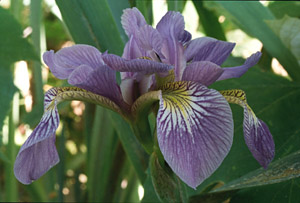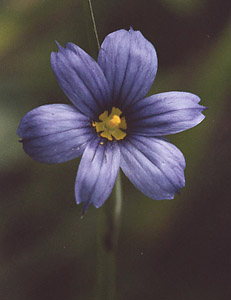



Greenish-flowered Pyrola, Wintergreen or Pyrola family (Pyrolaceae), Native
 |
 |
 |
 |

Blue Flag Iris, Iris family (Iridaceae), Native
 |
 |
 |
In early June, when cultivated irises begin to bloom in Westborough's gardens, the blue flag iris (Iris versicolor) appears at the water's edge at the Reservoir. The showy flowers are called flags because European rulers often decorated their banners, flags, and crowns with with designs based on the shape of the iris flower. In fact, the fleur-de-lis motif was derived from a kind of white iris.
The nectar in wild irises attracts a variety of insects,
but bumblebees are typically the ones that successfully transfer pollen from one flower to
another as they push inside.

Blue-Eyed Grass, Iris family (Iridaceae), Native
 |
 |
 |


In early June, woodland jack-in-the-pulpit (Arisaema atrorubens) appears in damp areas near streams and swamps, often in places where its relative, skunk cabbage, also grows. It is named for its resemblance to an old-fashioned pulpit with a "preacher" inside. The plant has also been called Indian turnip because Native Americans processed the bitter, sometimes caustic root in various ways so they could use it for medicine and food. Jack-in-the-pulpit plants live for several years, and the reproductive role of a plant changes with its age. Early in the life of a plant, most of its tiny flowers--clustered on the club-like "preacher"--are pollen-producing male flowers. A few years later, when the plant is larger and stronger, with more resources for seed-bearing, it produces mostly female flowers. In its later years, the plant may switch back to producing mostly male flowers. Some jack-in-the-pulpits at the Reservoir are all green, instead of striped and brownish as shown here. The plants' clusters of bright red berries are notable in late August or early September, before the autumn leaves turn. |
| show TOC frame | Table of Contents | 
|
| Home / Contact | ||
Copyright © Anne A. Reid, 1999-2002. Photographs copyright © Garry K. Kessler, 1999-2002. | ||